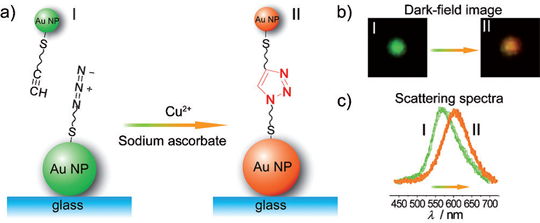Prof. Yi-Tao Long and his group have made a great progress on monitoring organic chemical reactions at single molecule level, which has been recently published on Angew. Chem. Int. Ed. (“Plasmon Resonance Scattering Spectroscopy at the Single-Nanoparticle Level: Real-Time Monitoring of a Click Reaction” DOI: 10.1002/anie.201301930).
In this work, a novel method for real-time monitoring of the click reaction by using PRRS (Plasmon Resonance Rayleigh Scattering) spectrometry and DFM (Dark-Field Microscopy) at single-nanoparticle level was established. By using Cu+-catalyzed azide-alkyne 1,3-dipolar cycloaddition (CuAAC) or click reaction, interparticle coupling was achieved. The resulting interparticle coupling covalently bound two different nanoparticles together, leading to a red-shift of PRRS spectra and a color change in DFM. This unique phenomenon and performance enabled the real-time monitoring organic reaction process as well as the amount of catalyst, providing a brand-new concept for catalytic reaction study. Furthermore, this nanoparticle system could be labeled as single-nanoparticle sensor for Cu (II) ion with a detection limit around 0.1 nM.
This research work was supported by the 973 Program, the National Science Fund for Distinguished Young Scholars and the National Nature Science Foundation of China. After 2 years’ of unremitting efforts, Ph. D student Shi Lei and Jin Chao, under the supervision of Prof. Yi-Tao Long, eventually succeeded on this project. Prof. Tony James and his colleagues from Bath University (UK) also cooperated on this work, under the support of RS-NSFC funding.





